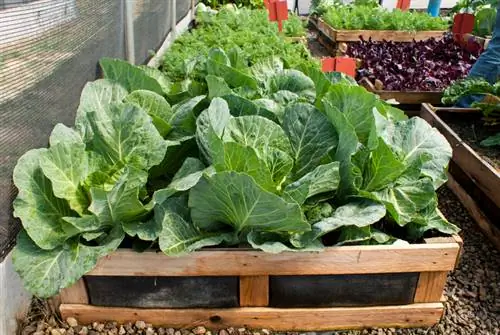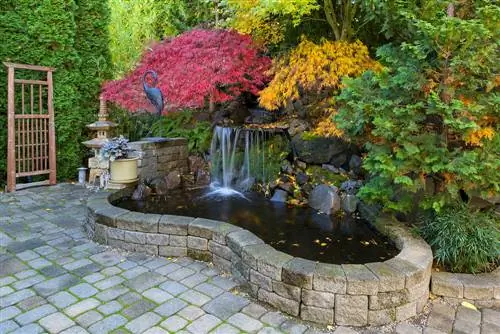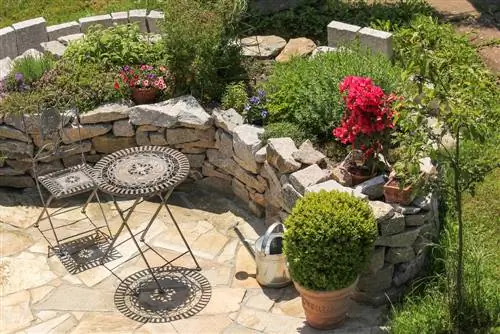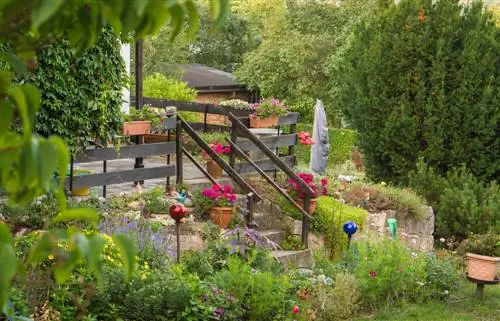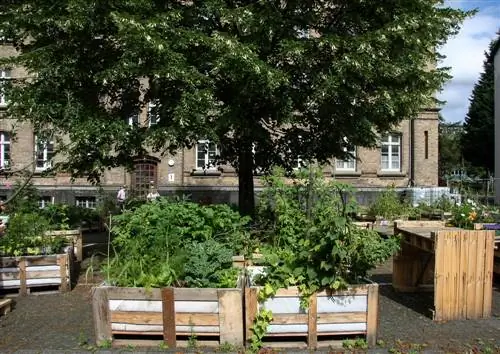- Author admin [email protected].
- Public 2023-12-16 16:46.
- Last modified 2025-01-23 11:21.
Raised beds are typically made of wood, but this material has serious disadvantages. Bricks are much more durable than wood; you can enjoy such a layered or brick raised bed for decades. In addition, such raised beds are even suitable for permanent planting with perennials or even small fruit trees, as the individual layers inside do not decompose as quickly.
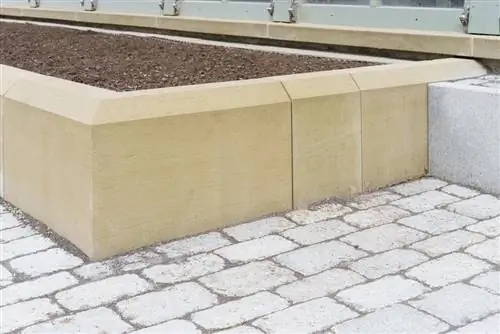
Why should you build a raised bed out of stone?
A stone raised bed offers advantages such as longevity, longer heat retention and is suitable for permanent planting. It can be built as a dry stone wall without mortar or with a mortared wall. Natural stone, brick, clinker or concrete blocks are suitable materials.
Advantages of stone raised beds
Although stone is initially more expensive and harder to process than wood, it has an almost unlimited lifespan. Once built, you don't need to rebuild such a raised bed every few years. In addition, the interior of a stone raised bed heats up more slowly than a wooden one due to the thicker walls, but it can retain the heat longer. This has a positive effect on plant growth, but also has an impact on the rotting process of the individual inner layers - these also rot more slowly and do not collapse as quickly, which is why stone raised beds are more suitable for permanent planting. In principle, even with these variants, the decomposed material must be removed after a few years and the bed replanted.
Types of Stone Raised Beds
There are two different ways to build a raised bed out of stone. With a dry wall, you simply layer the stones on top of each other without mortar or cement, while with mortared walls they are connected to each other using a suitable material and therefore permanently fixed. Please note, however, that dry stone walls take up more space for the same height, as the walls have to be built significantly wider than a mortared wall in order to be stable.
Drystone walls
You usually don't need a foundation for a drywall raised bed; instead, a level and sufficiently solid surface is sufficient. Tamp this firmly so that the stones do not tip or sink. If the soil in your garden is very soft (e.g. B. because the soil is very sandy), a simple foundation is recommended to increase stability. All types of natural stone, which can either be processed or not, are suitable as materials. However, stones that are not very well carved can only be brought into a reasonably closed shape with a flat upper edge with a lot of skill. In addition, the coarser the stone profiles, the larger the joints between the stones. However, you can take advantage of this by planting these loopholes with rock garden plants or suitable herbs.
How to Build a Simple Drywall Raised Bed
The easiest way to build a drywall raised bed is to use rectangular stones that are as smooth as possible. Use the largest and most even specimens for the bottom row. Then continue to build the drywall layer by layer until the final bed height is reached. Make sure that you do not stack the stones joint on joint, but rather offset from one another. They should be so stable on top of each other that they neither wobble nor tip. To level out any unevenness, you can wedge small pieces of stone into the remaining gaps. Then nothing will wobble anymore.
Raised bed with mortared wall
Mortarized walls can be built from regularly processed or cut natural stones, bricks, clinker bricks or even concrete blocks. In any case, a foundation must be placed under the walls of the raised bed so that it is sufficiently stable. There are different options for this:
- a 40 to 50 centimeter thick layer of crushed stone or gravel, compacted with a vibrating plate
- a foundation cast from concrete
Furthermore, a sufficiently deep pit must first be dug at the intended location of the raised bed. You finally build the walls of the raised bed on this foundation, whereby you have to pay careful attention to good sealing. Water must not penetrate anywhere, otherwise it will freeze in sub-zero temperatures in winter and destroy the wall.
Which types of stone are particularly suitable for raised beds
Raised stone beds can look very different. The market offers a large range of natural stones, but also shaped stones such as bricks and clinker bricks as well as molds cast from concrete. Which type of stone you ultimately choose depends on various factors. On the one hand, different materials naturally have different visual effects - but also their price. Natural stones such as granite, porphyry, travertine, limestone and sandstone look fantastic, but are also very expensive. Concrete blocks, on the other hand, are much cheaper to purchase and are easier to process due to their uniform size and shape. This also applies to bricks or clinker bricks, although simple clay bricks are usually not particularly stable and weatherproof. It is therefore better to use fired clay tiles or clinker bricks.
Tip
Natural stones are also available in the form of stone palisades or steles, which can be used to build extravagant and individual raised beds. Walls made of processed slate slabs also look particularly elegant. Since these are very expensive, build the walls of the raised bed from solid material (e.g. concrete or metal) and then only cover the front sides with them.


